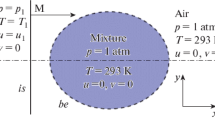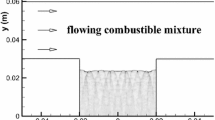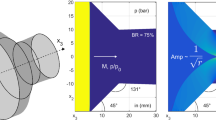Abstract
Interaction of a shock wave in a gas with a combustible high-density gas bubble is numerically simulated based on the Euler equations. Three qualitatively different modes of detonation initiation are described: direct initiation of detonation at the head of the bubble at sufficiently high Mach numbers of the incident wave and detonation initiation at the rear of the bubble due to wave refraction and the focusing of secondary shock waves at lower Mach numbers. It is shown that the detonation initiation mode largely depends on both the shock wave intensity and the density of the mixture in the bubble. Based on a series of computations, a diagram of initiation modes is constructed and it is shown that the effect of shock wave focusing ensures successful detonation initiation with a much lower intensity of the incident wave compared to direct initiation.





Similar content being viewed by others
REFERENCES
N. Apazidis and V. Eliasson, Shock Focusing Phenomena (Springer, 2019).
P. Yu. Georgievskiy, V. A. Levin, and O. G. Sutyrin, “Interaction of a Shock with Elliptical Gas Bubbles," Shock Waves 25 (4), 357–369 (2015); DOI: 10.1007/s00193-015-0557-4.
N. Haehn, D. Ranjan, C. Weber, J. Oakley, D. Rothamer, and R. Bonazza, “Reacting Shock Bubble Interaction," Combust. Flame 159 (3), 1339–1350 (2012); DOI: 10.1016/j.combustflame.2011.10.015.
F. Diegelmann, S. Hickel, and N. A. Adams, “Shock Mach Number on Reaction Wave Types and Influence Mixing in Reactive Shock-Bubble Interaction," Combust. Flame 174, 85–99 (2016); DOI: 10.1016/j.combustflame.2016.09.014.
F. Diegelmann, V. Tritschler, S. Hickel, and N. Adams, “On the Pressure Dependence of Ignition and Mixing in Two-Dimensional Reactive Shock-Bubble Interaction," Combust. Flame 163, 414–426 (2016); DOI: 10.1016/j.combustflame.2015.10.016.
P. Yu. Georgievskiy, V. A. Levin, and O. G. Sutyrin, “Combustible Gas Cylinder Detonation upon Incident Shock Focusing," Pis’ma Zh. Tekh. Fiz. 45 (23), 43–46 (2019) [Tech. Phys. Lett. 45 (23), 1209–1211 (2019); https://doi.org/10.1134/S1063785019120071].
V. A. Levin and V. P. Korobeinikov, “Strong Explosion in a Combustible Mixture of Gases," Izv. Akad. Nauk SSSR. Mekh. Zhidk. Gaza 6, 48–51 (1969).
A. Matsuo and T. Fujiwara, “Numerical Simulation of Shock-Induced Combustion around an Axisymmetric Blunt Body," in 26th Thermophysics Conf., Honolulu, 24–26 June, 1991; DOI: 10.2514/6.1991-1414.
G.-S. Jiang and C.-W. Shu, “Efficient Implementation of Weighted ENO Schemes," J. Comput. Phys. 126 (1), 202–228 (1996); DOI: 10.1006/jcph.1996.0130.
Z. He, L. Li, Y. Zhang, and B. Tian, “Consistent Implementation of Characteristic Flux-Split Based Finite Difference Method for Compressible Multi-Material Gas Flows," Comput. Fluids 168, 190–200 (2018); DOI: 10.1016/j.compfluid.2018.04.007.
J.-F. Haas and B. Sturtevant, “Interaction of Weak Shock Waves with Cylindrical and Spherical Gas Inhomogeneities," J. Fluid Mech. 181, 41–76 (1987); DOI: 10.1017/S0022112087002003.
Author information
Authors and Affiliations
Corresponding author
Additional information
Translated from Fizika Goreniya i Vzryva, 2022, Vol. 58, No. 5, pp. 72-78.https://doi.org/10.15372/FGV20220509.
Rights and permissions
About this article
Cite this article
Georgievskiy, P.Y., Levin, V.A. & Sutyrin, O.G. Detonation Initiation upon Interaction of a Shock Wave with a Combustible Gas Bubble of Various Densities. Combust Explos Shock Waves 58, 571–576 (2022). https://doi.org/10.1134/S0010508222050094
Received:
Revised:
Accepted:
Published:
Issue Date:
DOI: https://doi.org/10.1134/S0010508222050094




